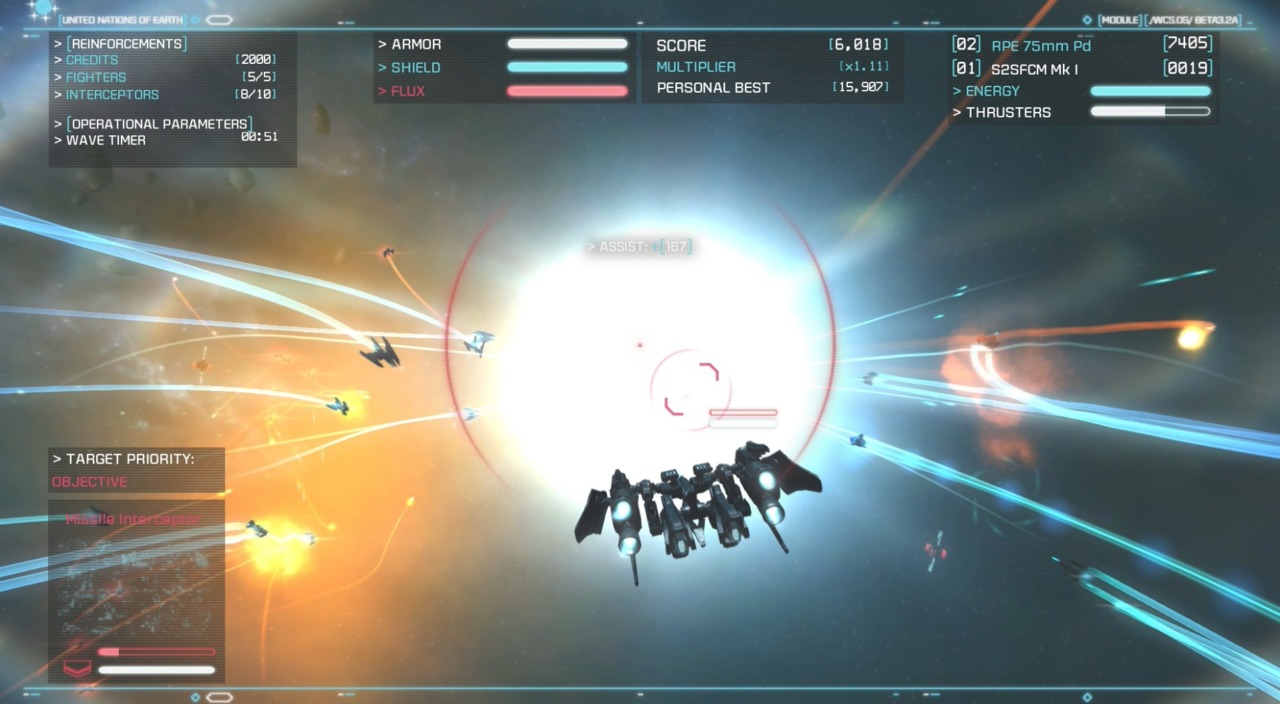If the title Strike Suit Infinity sounds familiar, you might be confusing it with Strike Suit Zero, the space-mech combat game that was released back in January. Its fast-paced battles were beautifully rendered, and a bit unbalanced at times, but Zero offered just the right mix of arcade-inspired action and intergalactic vistas to keep things interesting through to the end. Sadly, for a $20 game, there simply wasn’t enough variety in the action or mission structure. For Infinity, developer Born Ready Games stripped the Strike Suit experience down to its core mechanics, offering a stand-alone horde mode for $7. It’s a smart move; the most redeeming quality of Zero was its gameplay, after all. While it’s good to see a game embrace its strengths so wholeheartedly, there are a myriad of smaller issues that hold Infinity back from greatness, despite its improved value.
Your task couldn’t be more straightforward: survive and defeat waves of enemy combatants. In your transforming jet mech strike suit, you fly through outer space, whittling away at opposing spacecraft with energy cannons, lock-on missiles, and thousands of rounds of smaller munitions. Collect enough flux by defeating enemies, and you can transform into the strike suit’s bipedal form, which brings increased firepower and defense. Each round is a heady mix of speed, explosions, and tense face-offs, the culmination of which makes Strike Suit Infinity a captivating and challenging experience.
Survival is often difficult, since each round of waves pummels you with denser enemy formations and increasingly more powerful ships, but chasing the top of the online leaderboards is the ultimate challenge in Infinity. Even though it may seem impossible to leave your mark on the overall leaderboard, you can also compete for the per-round leaderboards, challenging previously defeated rounds a la carte.
Before the start of a round, you’re given hints about the types of enemies you’ll face in the waves to come, and what weapons might be most effective, but it takes more than a little advanced knowledge to come out on top. Strike Suit Infinity rewards fast reflexes and experience, and the room for skill development is impressive, with the top ranked players hitting scores 100 times larger than your own in some cases. Reaching that same high level of play seems insurmountable, but every defeat leads to new lessons and a better understanding of what you must do to prevail.

Of course, you must first overcome the strike suit’s complex capabilities. To be able to accelerate, brake, maneuver, transform, fire weapons, avoid enemy fire, and deploy a missile-scrambling EMP burst in a matter of a couple of seconds requires some serious coordination. Thankfully, the controls are comprehensive and responsive, leaving little to be desired in the way of mech management once they sink in. When dialed in during the heat of battle, good players will be able to handle most things thrown their way. The difference between a good and a great player, however, is the ability to earn score multipliers, effectively manage resources, and locate the fleeting and hard-to-locate upgrades, hidden in relatively far off transports and freighters.
Aiding you on your mission are ally squads, purchased with credits earned during the previous rounds. While not so important at the start, it’s critical that you manage your fleet, and thus your pool of credits, during later rounds against frigates, mine layers, and the infamous Black Fleet. Squads are defined by their class, which range from nimble Interceptors to Heavy Fighters and Bombers. Instead of picking up new recruits, you may choose to spend credits to level up your entire team, but it’s entirely unclear what aspects get upgraded in the process. Do your ships gain speed? Does their AI improve? You don’t know, because the game doesn’t tell you. The same goes for the upgrades that you earn for your strike suits; +2 to armor sounds good on paper, but it’s impossible to quantify what that actually means.
Apart from introducing the simple joys of arcade-like skill progression, Strike Suit Infinity also features the Marauder and Raptor strike suits, the latest DLC add-ons for Strike Suit Zero. Their qualities vary in the typical way: the Marauder has increased firepower and shield ratings at the cost of speed, while the opposite is true for the Raptor. They’re interesting diversions that prove to be distinct in practice, providing a simple means of mixing up the dynamics of conflict. What would cost $2.99 to add into Strike Suit Zero is available in Infinity from the start, a fact that may mean little to newcomers, but might prove enticing to existing owners of Zero who have yet to purchase the DLC. The differences between the three strike suits may not be tailored for use during specific rounds, but when roadblocked by a difficult round, switching suits is a fast and dirty way of alternating your approach.
There are nagging imperfections in the game’s upgrade system that can be demotivating when budgeting credits, but the omission of specific numbers doesn’t tarnish the joys of combat. Strike Suit Zero cost a comparatively hefty sum for its somewhat brief campaign, but Infinity could take months to master, at a fraction of the cost. It’s unfortunate for strike suit veterans that Infinity isn’t available as an add-on to Zero, but as a stand-alone game, it’s an excellent slice of mech combat presented under the guise of an old-school arcade game; bonus rounds and all.
